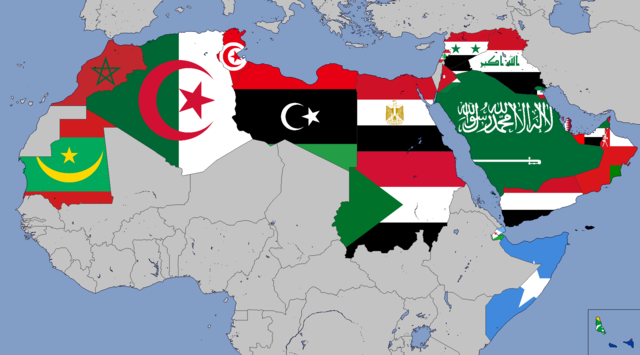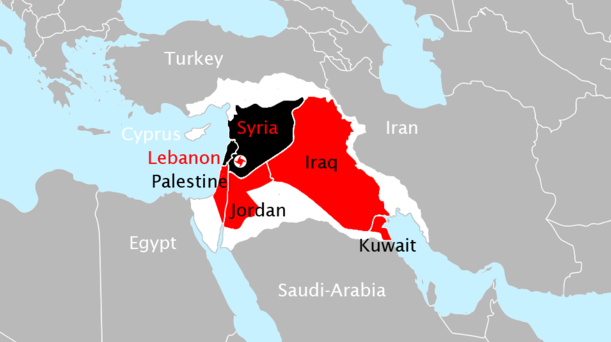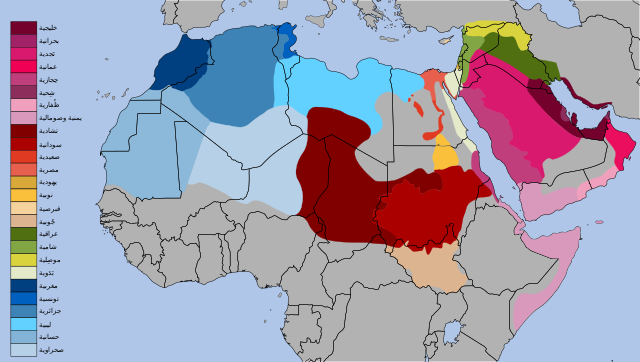The Arab World: What Unites Us?

The Arab World on a Map. Photo: Wikimedia
By: Joud Sleilaty / Arab America Contributing Writer
In a world filled with diversity, the Arab world stays a region where various nations and cultures are intertwined in a complex tapestry. From North Africa to the Levant and the Arabian Peninsula, the Arab world encompasses a diverse group of countries with rich histories, languages, and traditions. While it may seem that this diversity would lead to division, the Arab world is bound by several factors that unite its people in unique ways.
Geography: A Shared Landscape
One of the most fundamental factors that unites the Arab world is geography. Despite the political divisions and some persisting conflicts that might be the source of separation between Arab nations, the region is still a connected landmass by the nations’ borders. While these borders are closed unlike US states or EU countries, and may sometimes even be impenetrable due to political tensions, the geographic proximity of Arab countries cannot be overlooked. Uniting the Southwest Asian and North African countries together as one group is therefore partially a consequence of their proximity.
Furthermore, colonialism has tightly integrated into the history of the Arab world. Many Arab nations were formerly under the rule of the same colonial empires, including the British, French, Ottoman, and even the Roman Empire. This common colonial past has significantly impacted the region, molding political structures, borders, and even cultural norms.
The division of larger countries into multiple smaller ones also illustrates the geographical connections within the Arab world. For example, the modern countries of Syria, Lebanon, Jordan, Iraq and Palestine were all part of the Greater Syria region under the Ottoman rule and were only divided into distinct nations after World War I. This historical geographical connection greatly portrays the region’s unity in its diversity.

Greater Syria Map. Photo: Wikimedia
History and the Way We Face Crisis
Arab nations share a history marked by colonization, struggles for independence, periods of success, prosperity, but also times of extreme crises and famine. The Arab world’s experience of colonization by the same foreign powers, like Britain, France, and the Ottoman Empire, created a sense of collective identity rooted in the shared history of oppression.
Throughout history, the Arab world has faced numerous crises, and the response to these challenges often demonstrated a sense of solidarity. The Arab Spring, which began in Tunisia in 2010 and spread across the region, is a prime example of how Arab nations can come together in times of crisis. The wave of protests and demands for change echoed through various countries, highlighting the shared experiences of oppression faced by Arab nations.
A historic example of Arab unity in times of crisis is the 1948 Arab-Israeli War. With the establishment of the State of Israel, several Arab countries, including Egypt, Jordan, and Syria, came to the aid of Palestine. This solidarity, rooted in a shared sense of injustice and a common identity, highlights the deep connections within the Arab world. This is why we call it the Arab-Israeli War and not the Palestine-Israel War, as it underscores the collective Arab response to a common cause.
Religion: A Common Faith
Religion plays a significant role in uniting the Arab world. The majority of people in the Arab region are Muslims, sharing the same faith, traditions, and values. Islam serves as a powerful cultural and spiritual bond that transcends national boundaries.
However, it’s essential to recognize that there are exceptions to this religious unity. For example, the Levant, particularly Lebanon, has a significant Christian population, making it one of the most religiously diverse countries in the region. Although, it’s important to note that religious diversity in the Arab world can sometimes lead to divisions, but common cultural and historical ties still play a unifying role.
Language: A Shared Arabic Base
Language is another unifying factor in the Arab world. Arabic serves as a common linguistic thread that connects the region, despite the existence of various dialects. These dialects may differ from one country to another, and sometimes even within the same country, but the core Arabic language remains the same.
The shared Arabic language promotes communication, cultural exchange, and mutual understanding among Arab nations. Even though dialects can differ significantly between countries, and sometimes to the point of mutual unintelligibility, this is similar to dialect differences within a single country, which doesn’t necessarily imply separate nationalities.

Map of the Arabic Dialects. Photo: Wikimedia
Rules, Norms, and Values: Common Ground
Arab nations also share common values, norms, and rules to a considerable extent. The region’s cultural and religious heritage plays a pivotal role in shaping the ethical and moral standards that are prevalent throughout the Arab world. While there may be variations in the interpretation and application of these values, especially based on religious beliefs, the shared basic principles tie the region together.
Additionally, Arab societies often exhibit more traditional norms and conservative values compared to many Western nations. These shared values contribute to a collective identity that transcends national borders and unites the Arab world as a whole.
The Way the World Views Us: A Shared Perspective
Externally, the world often views the Arab world as a unified entity. Non-Arabs often perceive the region as a single, undifferentiated entity, paying little to no attention to the linguistic and cultural differences that exist within the Arab world.
Unfortunately, this shared perspective does not necessarily always have a positive context. Being “Arab” often has a negative connotation to it. Discrimination against Arabs, stereotyping, and prejudice are challenges that Arabs collectively face. While it may be more pronounced for specific Arab nationalities, the primary discrimination is often directed at all Arabs or individuals who have an Arab appearance. The broader global perspective on the Arab world often fails to differentiate between its diverse cultures and nations, leading to widespread misconceptions and bias.
Arab Pride: A Path to Unity
For the Arab world to be seen as a united entity, it is essential for its people to take pride in their shared Arab identity. This sense of Arab pride goes beyond national borders and creates a stronger sense of unity not just within each country but also within the whole region. Ironically, people who might have never lived in an Arab country but proudly identify with their Arab background can feel more connected to the Arab world than those who might have spent their whole lives in an Arab nation but do not consider themselves Arab.
In some countries within the Arab world, it is normal for people to identify as non Arabs. For example, Morocco is one of many Arab nations. However, only 67% of its population identifies as Arabs. Other populations like Berbers and Sahrawis also live within Morocco and even though they consider themselves moroccans, they are not Arabs. Additionally, a portion of the christian population in Lebanon, identify themselves as Phoenicians and non Arabs.
Conclusion
In conclusion, the Arab world is a region marked by diversity, but it is united by various factors that transcend political boundaries. Geography, history, religion, language, shared values, and external perceptions all play a role in creating a sense of unity among the people of the Arab world. While religion, language, and geography are essential elements of this unity, it is the shared experiences and challenges faced by the Arab nations that truly bring them together.
In today’s interconnected world, the challenges faced by the Arab world and the way it is perceived by outsiders continue to reinforce the sense of unity among its people. Social media, international media coverage, and global events all contribute to a shared Arab experience that transcends national borders.
In the end, the Arab world’s unity lies in its diversity, as its people find strength and solidarity in their shared history, culture, and identity. While there may be differences within the Arab world, it is the shared sense of being part of a larger whole that ultimately unites its diverse nations and peoples.
Check out Arab America’s blog here!








